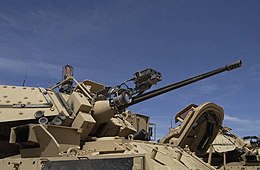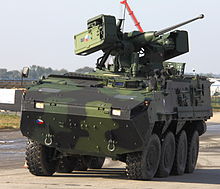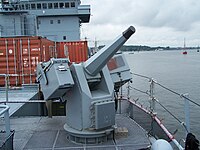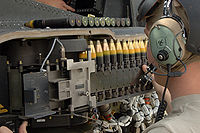Autocannon
This article needs additional citations for verification. (June 2009) |

| Part of a series on |
| Cannons |
|---|
 |
An autocannon, automatic cannon or machine cannon is a
Autocannons are heavy weapons that are unsuitable for use by
) rounds.Although capable of generating extremely rapid
attacks, where the target dwell time is short and weapons are typically operated in brief bursts.History
Early developments

The first modern autocannon was the British
In 1913, Reinhold Becker and his Stahlwerke Becker firm designed the
During the
Second World War
Autocannons would serve to a much greater extent and effect during the
The Polish 20 mm 38 Fk auto cannon was expensive to produce, but an exception. Unlike the Oerlikon, it was effective against all the tanks fielded in 1939, largely because it was built as an upgrade to the Oerlikon, Hispano-Suiza, and Madsen. It even proved capable of knocking out early Panzer IIIs and IVs, albeit with great difficulty. Only 55 were produced by the time of the Polish Defensive War. However it was in the air war that these weapons played their most important part in the conflict.
During the First World War, rifle-calibre machine guns became the standard weapons of military aircraft. In the Second, several factors brought about their replacement by autocannon. During the inter-war years, aircraft underwent extensive evolution and the all-metal monoplane, pioneered as far back as the end of 1915, almost entirely replaced wood and fabric biplanes. At the same time as they began to be made from stronger materials, the machines also increased in speed, streamlining, power and size, and it began to be apparent that correspondingly more powerful weapons would be needed to counter them. Conversely, they were becoming much better able to carry exactly such larger and more powerful guns; the technology of which was in the meantime also developing, providing significantly improved rates of fire and reliability.
When the Second World War did break out, it was swiftly realised that the power of contemporary aircraft allowed armour plate to be fitted to protect the pilot and other vulnerable areas. This innovation proved highly effective against rifle-calibre machine gun rounds, which tended to
Weapons such as the
The German
The German
-
GermanBK 5 50 mm aircraft autocannon displayed in front of the Me 262Ajet, a design once tested with it
-
Automatic Grenade Launcher, part of the cancelled OCSWprogram
-
An MLG 27 remote controlled autocannon of the German Navy
-
The 20 mm Oerlikon, an early autocannon
-
30mm × 113 mm rounds being loaded into a M230 chain gun
Modern era

The development of guided missiles was thought to render cannons unnecessary and a full generation of western fighter aircraft was built without them. In contrast, all Eastern Bloc aircraft kept their guns.[7] During the Vietnam War, however, the United States Air Force realized that cannons were useful for firing warning shots and for attacking targets that did not warrant the expenditure of a (much more expensive) missile, and, more importantly, as an additional weapon if the aircraft had expended all its missiles or enemy aircraft were inside of the missiles' minimum target acquisition range in a high-G close range engagement. This was particularly important with the lower reliability of early air-to-air missile technology, such as that employed during the Vietnam War. As a consequence, fighters at the time had cannons added back in external "gun pods", and virtually all fighter aircraft retain autocannons in integral internal mounts to this day.

After the Second World War, autocannons continued to serve as a versatile weapon in land, sea, and air applications. Examples of modern autocannons include the 25 mm
See also
- Chain gun
- Gast gun
- Infantry support gun
- List of autocannon
- Recoil operation
- Revolver cannon
- Rotary cannon
References
- ^ "Oerlikon KBA Description". WeaponSystems.net. Archived from the original on 2020-12-04.
- ^ The GSh-6-30K, a six-barreled Russian rotary autocannon, has a ROF of 6,000 rounds per minute. Williams, p. 241.
- ^ a b "Cannon or Machine Gun". Archived from the original on 2020-01-27. Retrieved 2020-05-12.
- ^ "World War 2 Fighter Gun Effectiveness". Archived from the original on 2017-10-30. Retrieved 2020-05-12.
- ^ The Encyclopedia of Aircraft of WWII. Editor Paul Eden.
- ^ The Machine Gun. George M. Chinn.
- ISBN 0-517-41265-9
- ^ "Freccia IFV (2006)". www.tanks-encyclopedia.com. Retrieved 2021-02-28.
Further reading
- Department of the Army. Ballistic Data Performance of Ammunition, TM 9-1907. Washington, D.C.: Government Printing Office, 1948. OCLC 169935419.
- Williams, Anthony G. The Development of Automatic Cannon, Heavy Machine Guns and Their Ammunition for Armies, Navies and Air Forces. Shrewsbury, Eng.: Airlife Publishing Ltd., 2000. OCLC 1109578149.





